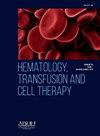Incidence of hepatocellular carcinoma in beta thalassemia: a systematic review and meta-analysis
IF 1.6
Q3 HEMATOLOGY
引用次数: 0
Abstract
Background
Current evidence indicates that iron overload increases the risk of hepatocellular carcinoma. However, the incidence of hepatocellular carcinoma in thalassemia is still unclear. This review aims to summarize the current evidence regarding the incidence of hepatocellular carcinoma in thalassemia patients.
Methods
Detailed searches were conducted in several databases, including PubMed, Europe PMC, EBSCOHost, and ProQuest. Keywords such as “thalassemia” and “hepatocellular carcinoma,” along with other relevant synonyms, were used. Articles investigating the incidence of hepatocellular carcinoma in thalassemia patients were included. Pooled estimates were calculated using the DerSimonian Laird inverse-variance random effect model and presented as incidence (%) along with their 95 % confidence intervals and 95 % prediction intervals.
Results
From a total of 318 articles, five studies encompassing a total of 9592 thalassemia patients were included in this study. The cumulative incidence of hepatocellular carcinoma in thalassemia patients was 1.96 % (95 % confidence interval: 0.88 %–4.27 %; prediction interval: 0.12 %–24.74 %; I2 = 86.8 %). Of the 139 hepatocellular carcinoma patients, 121 were reported positive for anti-HCV, 78 for HCV RNA, three for HbsAg, and 50 positive for anti-HBV or had past infections. The liver iron concentration and ferritin level ranges in all studies were 2.95–10.5 mg/g and 3.1–2950 µg/L, respectively.
Conclusions
The present meta-analysis demonstrates that the incidence of hepatocellular carcinoma in thalassemia patients was high (1.96 %). It might be caused by liver infection, iron overload, or something else.
-地中海贫血中肝细胞癌的发生率:一项系统回顾和荟萃分析
背景:目前的证据表明,铁超载会增加肝细胞癌的风险。然而,地中海贫血中肝细胞癌的发生率尚不清楚。这篇综述旨在总结目前关于地中海贫血患者肝细胞癌发病率的证据。方法在PubMed、european PMC、EBSCOHost、ProQuest等数据库中进行详细检索。使用了“地中海贫血”和“肝细胞癌”等关键词以及其他相关同义词。纳入了研究地中海贫血患者肝细胞癌发生率的文章。汇总估计使用DerSimonian Laird逆方差随机效应模型计算,并以发生率(%)及其95%置信区间和95%预测区间表示。结果本研究共纳入318篇文献,5项研究共纳入9592例地中海贫血患者。地中海贫血患者肝细胞癌的累积发病率为1.96%(95%可信区间:0.88% - 4.27%;预测区间:0.12% - 24.74%;I2 = 86.8%)。在139例肝细胞癌患者中,121例抗HCV阳性,78例HCV RNA阳性,3例HbsAg阳性,50例抗hbv阳性或既往感染。所有研究的肝铁浓度和铁蛋白水平范围分别为2.95 ~ 10.5 mg/g和3.1 ~ 2950µg/L。结论本荟萃分析表明,地中海贫血患者肝细胞癌的发生率较高(1.96%)。它可能是由肝脏感染、铁超载或其他原因引起的。
本文章由计算机程序翻译,如有差异,请以英文原文为准。
求助全文
约1分钟内获得全文
求助全文
来源期刊

Hematology, Transfusion and Cell Therapy
Multiple-
CiteScore
2.40
自引率
4.80%
发文量
1419
审稿时长
30 weeks
 求助内容:
求助内容: 应助结果提醒方式:
应助结果提醒方式:


